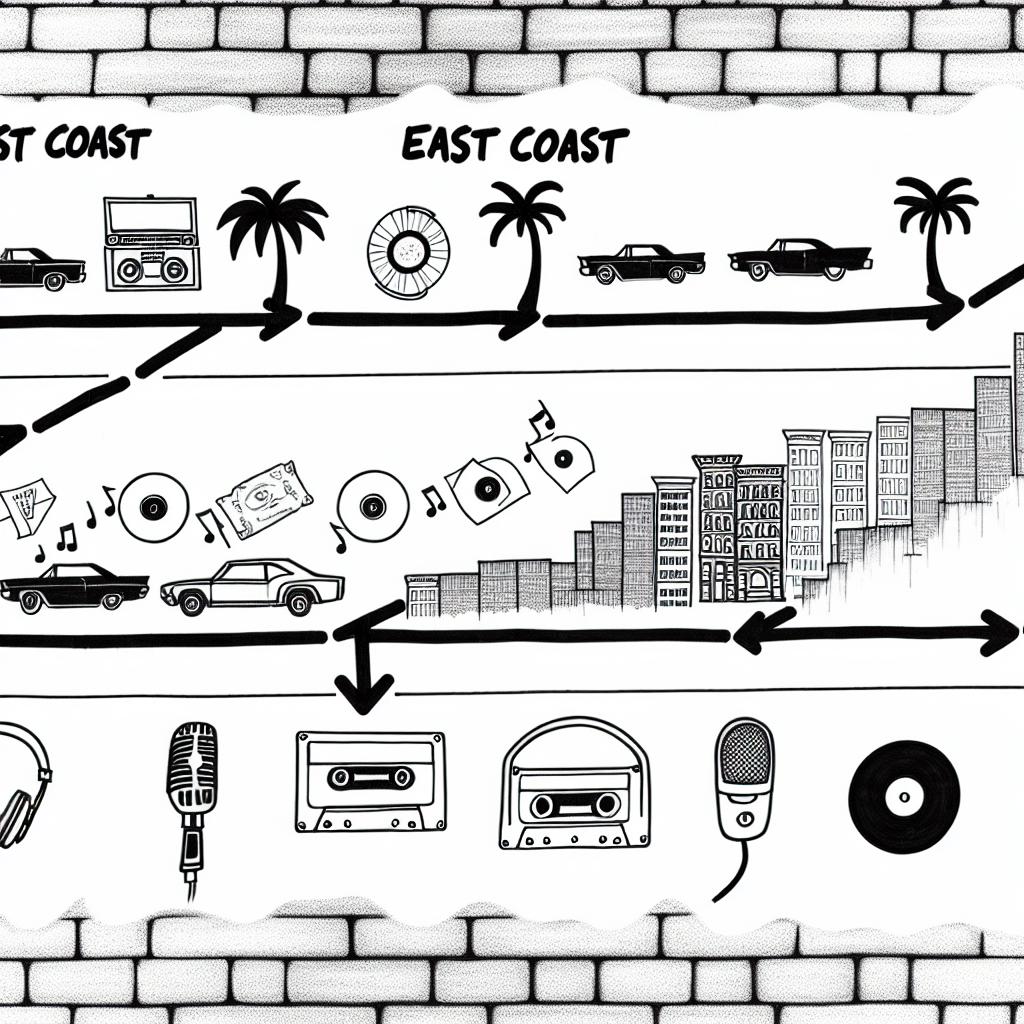The Origins
The evolution of West Coast versus East Coast rap represents a pivotal era in hip-hop history, underscoring a unique geographical and cultural division that profoundly influenced the genre’s development. The roots of hip-hop can be traced back to the East Coast, especially New York City, in the 1970s. This urban environment became the fertile ground where hip-hop was born, with its identity deeply intertwined with the city’s gritty and vibrant streets. Pioneering artists such as Grandmaster Flash, the Sugarhill Gang, and Run-D.M.C. were instrumental in creating a sound characterized by rhythmic beats and complex lyricism. Through their innovative use of DJing, breakdancing, graffiti, and MCing, these artists laid down the foundational elements of hip-hop culture.
As the East Coast established itself as the epicenter of early hip-hop movements, a distinct identity began to emerge with the West Coast in the 1980s. Los Angeles became a nucleus for a fresh wave of hip-hop characterized by its own unique style and sound. This West Coast sound was significantly influenced by the socially conscious themes that permeated its music, often addressing issues like police brutality and systemic inequality. Artists such as N.W.A and Ice-T were prominent voices in this movement, incorporating funk influences that would come to define the West Coast style. Their music highlighted the experience of living in urban Los Angeles, resonating with many listeners and marking a significant divergence from the East Coast aesthetic.
The Golden Age
The 1990s are often celebrated as the golden age of hip-hop, a period when the East Coast vs. West Coast rivalry reached its zenith. During this time, the East Coast maintained its sway over the genre with artists such as Nas, The Notorious B.I.G., and the Wu-Tang Clan leading the charge. These musicians were celebrated for their gritty storytelling—a reflection of the New York City urban landscape—and for their intricate wordplay that showcased linguistic prowess. The narratives crafted in their lyrics often drew a picture of life in the bustling, and sometimes unforgiving, metropolis.
Concurrently, the West Coast experienced its own ascension with a sound that captured the distinct vibes of California. This sound was personified by G-funk, a subgenre that skillfully blended elements of gangsta rap with the laid-back beats of funk. Figures such as Dr. Dre, Snoop Dogg, and Tupac Shakur were at the forefront of this movement, brilliantly encapsulating the essence of Californian lifestyle in their music. Their tracks often exuded a smooth, relaxed feeling while simultaneously addressing the realities and challenges of their environment.
The Rivalry Intensifies
As the two coasts cultivated their distinct identities, the rivalry between East Coast and West Coast hip-hop communities intensified in the mid-1990s. This contention was propelled by media sensationalism that exaggerated territorial disputes and personal animosities. At the heart of this conflict were two influential record labels: Death Row Records from the West Coast and Bad Boy Records from the East Coast. The personal disputes between the leading figures of these labels, particularly between artists Tupac Shakur and The Notorious B.I.G., became emblematic of the wider feud.
This period saw a stream of seminal album releases that highlighted the distinctive sounds of each coast while also directly addressing the ongoing rivalry. Tracks such as Tupac’s “Hit ‘Em Up” and The Notorious B.I.G.’s “Who Shot Ya?” exemplified the personal and professional tensions that found expression in their music. These songs were not just battles through lyrics but were reflective of the stark realities and communication breakdowns prevalent during that era.
The Aftermath
The rivalry’s tragic peak was marked by the untimely deaths of Tupac Shakur in 1996 and The Notorious B.I.G. in 1997. The murders of these iconic figures sent shockwaves throughout the music industry, prompting a period of profound reflection among hip-hop communities. The events underscored the dangerous escalation of rivalries fueled by miscommunications and magnified by the media.
In the aftermath, the aggressive competition transformed into a path toward healing and collaboration. Artists from both coasts began to engage in collaborations, bridging the divide that had previously existed. The late 1990s and early 2000s saw a newfound camaraderie as artists from oppositional backgrounds united to elevate the genre. This period highlighted a broadening of hip-hop’s reach and influence, marking its emergence as a dominant force not just in American music but also on the global stage.
The Unified Present
Today, the legacy of the East Coast vs. West Coast rap rivalry is apparent in the collaborative spirit that now defines the genre. Hip-hop artists frequently collaborate across geographical boundaries, creating music that embodies a fusion of styles and influences from both coasts. The distinctions that once defined East and West have now blended, allowing for a richly diverse hip-hop culture.
Hip-hop’s transformation into a diverse and global phenomenon stands as a testament to its adaptive and inclusive nature. The foundations laid during the early days of regional rivalries continue to impact contemporary music and culture. The essence of collaboration, creative expression, and cultural exchange reigns supreme, proving that hip-hop is a genre of unity and innovation.
Should you wish to explore more about individual artists or albums mentioned in this history, resources such as AllMusic or Rolling Stone offer extensive insights and analyses into the evolution and impact of hip-hop as a genre.


